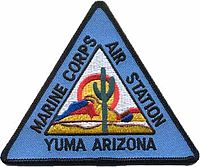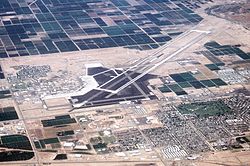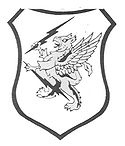- Marine Corps Air Station Yuma
-
Marine Corps Air Station Yuma 
Aerial photo as of 15 June 1992 IATA: none – ICAO: KNYL – FAA LID: NYL Summary Airport type Joint Military-Civilian Operator United States Marine Corps Location Yuma, Arizona Built 1928 In use 1959- present Commander Colonel Robert C. Kuckuk Occupants Marine Aircraft Group 13
MAWTS-1Elevation AMSL 216 ft / 66 m Coordinates 32°39′24″N 114°36′22″W / 32.65667°N 114.60611°WCoordinates: 32°39′24″N 114°36′22″W / 32.65667°N 114.60611°W Website Runways Direction Length Surface ft m 3L/21R 13,300 4,054 Concrete 3R/21L 9,241 2,817 Asphalt/Concrete 8/26 6,146 1,873 Asphalt/Concrete 17/35 5,711 1,741 Asphalt/Concrete Sources: official site[1] and FAA[2] Marine Corps Air Station Yuma or MCAS Yuma (ICAO: KNYL, FAA LID: NYL) is a United States Marine Corps air station which is the home to multiple squadrons of AV-8B Harrier IIs of the 3rd Marine Aircraft Wing, Marine Aviation Weapons and Tactics Squadron 1 (MAWTS-1) and Marine Fighter Training Squadron 401 (VMFT-401), an air combat adversary squadron of the 4th Marine Aircraft Wing of the Marine Corps Reserve.
The station is located 2 miles (3 km) from the city of Yuma, Arizona. A joint civilian-military airport, MCAS Yuma shares facilities with Yuma International Airport and occupies approximately 3,000 acres (1,200 ha), most of which is flat desert wilderness.
Contents
Tenant commands
- Headquarters and Headquarters Squadron
- Marine Aircraft Group 13
- Marine Aviation Weapons and Tactics Squadron 1
- Marine Air Control Squadron 1
- Combat Logistics Company 16
- Marine Wing Support Squadron 371
- VMFT-401
History
Air Force use
In 1928, the federal government purchased 640 acres (260 ha) near Yuma at the recommendation of Colonel Benjamin F. Fly. Temporary dirt runways were installed for usage by military and civilian planes. It was called Fly Field.
The outbreak of World War II transformed the civilian airport into the Yuma Army Airfield. Construction of facilities began on 1 June 1942 and was activated on 15 December
Yuma AAF was a single-engine flight training school, operated by the Army Air Forces Flying Training Command, West Coast Training Center, with flying training beginning in January 1943. Its training unit was the 307th Single Engine Flying Training Group which operated AT-6 Texans, with the base operating unit being the 403d Army Air Force Base Unit. In 1944, the unit was upgraded to multi-engine flight training, operating B-26 Marauders. In addition to the flying training, a Flexible Gunnery School was established at the airfield in November 1943. Flight training was discontinued on 23 April 1945 and gunnery training on 31 May 1945.
The base was closed on 1 November 1945. After the war, the airfield was turned over to the Department of the Interior as a headquarters for the Bureau of Land Reclamation.
On 1 January 1954, Yuma County Airport was reactivated by the United States Air Force Air Defense Command (ADC) as a training facility. In the mid-1950s, ADC was equipped almost solely with rocket-firing F-86D Sabre and F-89C Scorpion interceptors, and Headquarters USAF decided they should have their own training base.
Yuma Airport became the home of the 4750th Training Wing (Air Defense). The 4750th had two major components, the 4750th Training Group (Air Defense) and the 4750th Training Squadron. The group had two flying squadrons assigned - the 4750th TS equipped with six F-86D Sabres and six F-94Cs Scorpions: and the 4750th Tow Target Squadron equipped with twelve T-33As and eight B-45As used to tow targets for the live fire portion of the course.
The first ADC squadron arrived at Yuma for the Rocketry Proficiency Program on 1 February 1954. ADC squadrons rotated through Yuma on a regular basis for a two week proficiency program that included 'live-fire' exercises over the Williams AFB and Luke AFB gunnery ranges.
The two week course included a controller course, many hours in the F-86D simulator and at least one 'live fire' mission flown each day. The targets, usually towed behind B-45A tow ships, were 9'x45' target sleeves, with two radar reflectors attached for the interceptor fire control systems to lock onto. Most of the TDY personnel were quartered in tents near the flight line, at least until April 1954 when the first permanent barracks buildings were finished and air conditioned. By June, seven ADC units had rotated through the Yuma program.
Also Headquarters USAF decided to add a separate air-to-air rocketry competition to the annual USAF gunnery meet that was held at Las Vegas Air Force Base (renamed Nellis Air Force Base in 1950). The Interceptor Phase of the competition would be held at Yuma between 20 June and 27 June 1954. The competition would take place each year, with the last occurring in 1956.
Several changes occurred during the last half of 1954. On 24 August, Yuma County Airport was redesignated Yuma Air Force Base. On 1 September, the 4750th Training Wing became the 4750th Air Defense Wing (Weapons). The 4750th Group and squadrons were also redesignated. And on 8 January 1955, the 4750th Tow Target Squadron became the 17th TTS. Between July 1954 and the end of the year, ADC rotated eleven more squadrons through the Yuma program - nine in F-86Ds, and one each in F-94Cs and F-89Ds.
On 1 January 1956, the 4750th Drone Squadron was established as part of the 4750th ADW (Weapons). They were equipped with the brand new Ryan Q-2A Firebee drone, which was launched from GB-26C Invader aircraft. Although the drones were in place by Spring, the first GB-26Cs did not arrive until June, and the first Firebee flight took place in July. The Q-2A Firebees were recovered by H-21 helicopters after landing on the desert floor.
Yuma AFB was renamed on 13 October 1956 as Vincent Air Force Base, the installation was named for Brigadier General Clinton D. "Casey" Vincent, one of Major General Claire Chennault's top fighter leaders in the China-Burma Theater and the second youngest General Officer in U.S. Air Force history, receiving his star at the age of 29. Vincent was the subject of a TIME magazine article titled "Up Youth",[3] which covered the meteoric promotions of the Army and Air Force. Vincent was also an inspiration for the main character in the comic strip Terry and the Pirates. Vincent died of a heart attack in 1955 at the age of 40 while serving as the Deputy Chief of Staff for Operations, Air Defense Command (ADC) at Ent AFB, Colorado.[4]
In addition to the fighter units, Vincent AFB was used by Air Defense Command as a general surveillance radar station. The 864th Aircraft Control and Warning Squadron began operations in 1956 using AN/MPS-7 and AN/MPS-14 radars, the site being designated as "SM-162".
In addition to the main facility, Vincent AFB operated several AN/FPS-14 Gap Filler sites:
- Tacna, AZ (SM-162A): 32°41′01″N 114°03′07″W / 32.68361°N 114.05194°W
- Corn Springs, CA (SM-162B): 33°38′49″N 115°15′36″W / 33.64694°N 115.26°W
- Stone Cabin, AZ (SM-162C): 33°14′24″N 114°15′27″W / 33.24°N 114.2575°W
- Palo Verde, CA (SM-162D): 33°17′51″N 114°44′28″W / 33.2975°N 114.74111°W
Vincent AFB was transferred to the Navy on 1 Jan 1959, and the tenant radar site was renamed Yuma Air Force Station. On 20 July 1962, the base designation was changed to Marine Corps Air Station. In this time frame, the Air Force began construction of a new Yuma AFS (RSM-162) about 13 miles south of Yuma. However, the replacement site was never completed, as, in March 1963, the Air Force ordered the 864th AC&W Squadron to deactivate. Operations ceased 1 August 1963.[5][6]
Marine Corps use
The 4750th Air Defense Wing was inactivated at Vincent AFB on 15 June 1959 and control of the base was passed over to the United States Navy. Nine days later the base was turned over to the United States Marine Corps. The base was renamed Marine Corps Air Station Yuma (Vincent Field) on July 20, 1962.
MCAS Yuma is currently the busiest air station in the Marine Corps, offering excellent year-round flying conditions and thousand of acres of open terrain for air-to-ground weapons ranges and associated restricted airspace for military flight operations. During the 1960s, 70s and early 1980s, MCAS Yuma was home to VMFAT-101, the Marine Corps' Fleet Replacement Squadron (FRS) for the F-4 Phantom II, training U.S. Marine Corps, U.S. Navy and NATO/Allied flight crews and maintenance personnel in the F-4B, F-4J, F-4N and F-4S. Following the transfer of VMFAT-101 to MCAS El Toro, California in the 1980s, MCAS Yuma became the principal Fleet Marine Force Pacific operating base for the AV-8 Harrier and AV-8B Harrier II under the cognizance of Marine Aircraft Group 13 (MAG-13).
Marine Aviation Weapons and Tactics Squadron 1 (MAWTS-1) is a major aviation command at MCAS Yuma, conducting training for all Marine Corps tactical aviation units, most notably the Weapons and Tactics Instructor (WTI) course. Marine Fighter Training Squadron 401 (VMFT-401) is a Marine Air Reserve squadron also based at MCAS Yuma, containing both active duty and Selected Marine Corps Reservists, providing aerial adversary/aggressor services and dissimilar air combat training (DACT) for all US military services and selected NATO, Allied and Coalition partners.
MCAS Yuma is currently programmed to become the Marine Corps' initial operating base for the F-35B variant of the F-35 Lightning II Joint Strike Fighter (JSF).
See also
- Arizona World War II Army Airfields
- List of United States Marine Corps installations
- List of USAF Aerospace Defense Command General Surveillance Radar Stations
Notes
- ^ MCAS Yuma, official web site
- ^ FAA Airport Master Record for NYL (Form 5010 PDF), effective 2008-07-31
- ^ "Up Youth", Time, June 19, 1944, http://www.time.com/time/magazine/article/0,9171,711843,00.html, retrieved 2008-01-22
- ^ http://www.generals.dk/general/Vincent/Clinton_Dermott/USA.html
- ^ A Handbook of Aerospace Defense Organization 1946 - 1980, by Lloyd H. Cornett and Mildred W. Johnson, Office of History, Aerospace Defense Center, Peterson Air Force Base, Colorado
- ^ Winkler, David F. (1997), Searching the skies: the legacy of the United States Cold War defense radar program. Prepared for United States Air Force Headquarters Air Combat Command.
References
 This article incorporates public domain material from websites or documents of the United States Marine Corps.
This article incorporates public domain material from websites or documents of the United States Marine Corps. This article incorporates public domain material from websites or documents of the Air Force Historical Research Agency.
This article incorporates public domain material from websites or documents of the Air Force Historical Research Agency.
- Shaw, Frederick J. (2004), Locating Air Force Base Sites History’s Legacy, Air Force History and Museums Program, United States Air Force, Washington DC, 2004.
- Manning, Thomas A. (2005), History of Air Education and Training Command, 1942–2002. Office of History and Research, Headquarters, AETC, Randolph AFB, Texas ASIN: B000NYX3PC
- Bibliography
- Larry Davis (1992), F-86 Sabre in Action, Squadron/Signal Publications
- Larry Davis & Marty Isham (1999), Yuma, Sabre Jet Classics, Volume 7 Number 3 Fall 1999
External links
- MCAS Yuma, official web site
- Yuma Army Airfield in World War II
- Yuma International Airport
- USMC Air Station Yuma Overview & PCS Information (MarineCorpsUSA.org)
Current military installations of ArizonaArmy  Air FieldDepotNavajoFortHeliportRangeCamp Florence • Camp Navajo • Western Army National Guard Aviation Training Site
Air FieldDepotNavajoFortHeliportRangeCamp Florence • Camp Navajo • Western Army National Guard Aviation Training Site
Marines  Air StationYumaRangeChocolate Mountain • Yuma
Air StationYumaRangeChocolate Mountain • YumaAir Force  Auxiliary FieldRange
Auxiliary FieldRangeFlying Training Flying Schools Eastern Flying Training Command · Central Flying Training Command · Western Flying Training CommandSpecialized Schools Bombardier · Contract Flying · Glider Training · Gunnery · Navigator
Technical Training Eastern Technical Training Command · Central Technical Training Command · Western Technical Training CommandCategories:- Airports established in 1928
- 1942 establishments
- United States Marine Corps air stations
- Buildings and structures in Yuma County, Arizona
- Military facilities in Arizona
- Airports in Yuma County, Arizona
- World War II Desert Airfields
- USAAF West Coast Training Center
- Military Superfund sites
- USAAF Gunnery School
- Airfields of the United States Army Air Forces in Arizona
Wikimedia Foundation. 2010.











